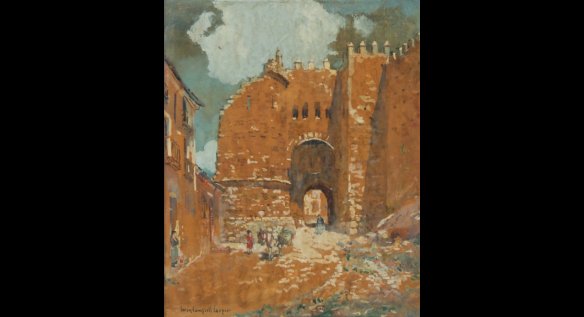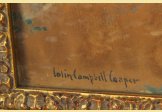Gateway at Sergovia
| Artist | : | Colin Cooper |
| Medium | : | Watercolor |
| Size unframed | : | 14"/17" |
| Size framed | : | 19"/22" |
| Signature Info | : | Hand Signed - By the artist |
| Frame Info | : | Yes |
| Condition | : | Excellent |
| Year | : | Unknown |
Description
This is an Original Watercolour & Gouache on paper by,Colin Campbell Cooper (American, 1856-1937) "Gateway at Segovia," Spain, signed bottom left, in a gilt wood frame. Size: 17.5" x 14.5", 44 x 37 cm (sight); 22.5" x 19.5", 57 x 50 cm (frame).
- Artist: Colin Campbell Cooper
- Title: "Gateway at Sergovia"
- Medium: Watercolour & Gouache on Paper
- Year: Unknown
- Edition: Unique, original work
- Size: 17.5 in x 14.5 in
- Signature: Hand signed by artist
COLIN CAMPBELL COOPER (1856-1937)
An Impressionist painter of oils and watercolors, Colin Campbell Cooper is best known for urban scenes, landscapes, and images of architectural structures. Highly successful during his era, Cooper portrayed architectural forms in city and country settings in America, Europe, and the Far East, creating images that continue to delight us today for their able draftsmanship, sparkling color, and ability to express the character of a place.
The son of a surgeon of Irish descent, Cooper was born in Philadelphia. At age twenty-three, he enrolled at the Pennsylvania Academy of the Fine Arts, where he studied with the famous realist painter, Thomas Eakins. Within the year that he began his training, Cooper first exhibited works at the Pennsylvania Academy. In 1882, he appears to have visited Taos, New Mexico, as he exhibited a work entitled The North Pueblo of Taos, New Mexico, at the Pennsylvania Academy annual of the year. In 1886, he departed for Europe. After visiting Holland and Belgium, where he created drawings of canals, he went to Paris. Continuing his studies, he enrolled at the Académie Julian and the Ecole Delecluse. At Julian’s he met many American artists who would soon adopt the French Impressionist aesthetic.
Cooper was enthralled with the architectural grandeur of Europe and traveled throughout the continent. Working en plein air, he created paintings and watercolors of Gothic tracery in Venice, bridges in Florence, ports in Amsterdam, towns in Spain and England, cathedrals in the French countryside, townsfolk and village streets in Normandy and Brittany, and châteaux along the Rhine.
By 1895 Cooper had returned to America, settling in his native Philadelphia, where he received significant acclaim for his work and had begun to teach watercolor classes at the Drexel Institute. In 1896 misfortune struck the artist when a fire at the Hazeltine Galleries in Philadelphia destroyed much of his earlier work, including a great number of Dutch genre scenes. The following year, Cooper married the painter Emma Lampert (1855-1920).
In 1902 Cooper began to paint scenes of New York City. His images were inspired by the Impressionist urban views of Childe Hassam, but Cooper focused to a greater extent on the skyscrapers and dramatic skylines of Manhattan than had Hassam, capturing the dynamism of the modern city and expressing respect for its architectural achievements. As one critic noted:
Colin Campbell Cooper . . . is pre-eminently the artist who has shown the modern world that there is beauty, even poetry, in its towering structures of steel, as well as old cathedrals laid stone by stone. He has transformed the canyons of New York for their denizens; he has not only celebrated the Metropolitan’s campanile, but revealed the unique beauty behind the ugliness of the Flatiron building, the glorious vaulting across great rivers. . . .[i]
After the turn of the century, Cooper made a number of additional trips to Europe, again seeking out and depicting picturesque and monumental architectural forms. In 1913, he made his first trip to India, where he used a bright pastel palette to record the exotic splendour of important landmarks, such as the Taj Mahal, the Jain Temple, and the Maharaja’s Temple at Jaipur. He also painted images of the Himalayas. Cooper made his first trip to California in 1915, when he was invited to exhibit work at the Panama-Pacific Exposition in San Francisco. In 1921 a year after his wife’s death, Cooper moved to Santa Barbara, California, where he became the dean of the School of Painting at the Santa Barbara School for the Arts. Taking delight in the agreeable climate and the beauty of the California landscape, Cooper created light-filled images of houses and gardens near his new home. He was married again in 1927, to Marie Frehsee. During his California years, Cooper returned to India and travelled to Burma.
Cooper was a member of the National Academy of Design, the Lotos Club, the Salmagundi Club, the New York Water Color Club, the American Water Color Society, the Philadelphia Water Color Club, and the Art Club of Philadelphia. He received awards from the Atlanta Exposition, 1895, the Pennsylvania Academy, 1904, the St. Louis World’s Fair, 1904, the Art Club of Philadelphia, 1905, the Panama-Pacific Exposition, 1915, the New York Water Color Club, 1918, and the San Diego Fine Arts Gallery, 1930.
Cooper’s work is represented in many important private and public collections including the Art Club of Philadelphia; the Boston Art Club; the Cincinnati Art Museum; the Dallas Art Museum; the Lotos Club, New York; the Pennsylvania Academy of the Fine Arts, Philadelphia; and the St. Louis Museum of Fine Arts.




